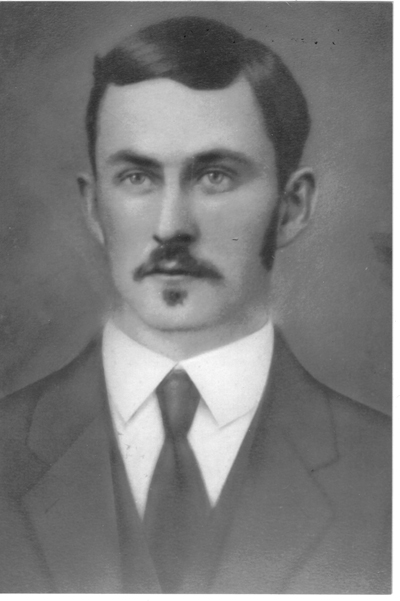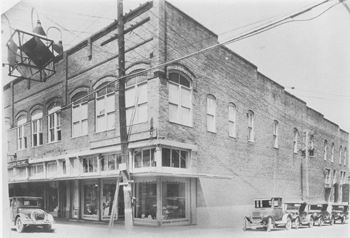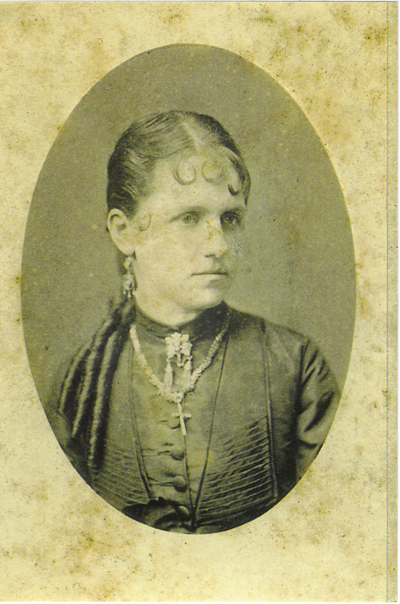 The Sam Webbs,
The Sam Webbs,
Contributed by John Agan,
(Photo to left: Samuel Grigsby Webb)
Friday, 23 March 2007
How two men of the same name contributed to Minden Last
week’s Echo of Our Past discussed the confusions caused
by the presence of two different families that spelled
their last name, Murrell, in 19th century Minden.
Another similar situation of the; problem took place in
19th and early 20th century Minden. This situation is
more complicated because of shared first names and
because the two families involved were related. Both
shared a common Webb ancestor and were descended from
the General Stephen Moore of the Revolutionary War era.
The confused identities in this case came from two
cousins named Sam. Today’s column looks at the story of
the two; Sam Webb’s; and the contributions of their
families to Minden. Both Sam Webbs played major roles in
the business and economic life of Minden’s past. First,
we will look at the family of Samuel J. Webb, inventor
and businessman, and his brother Robert Dickens Webb,
physician and businessman. Samuel J. Webb
and Robert D. Webb were the sons of Dr. Stephen Moore
Dickens Webb, born on May 5, 1826, in North Carolina.
Stephen M. D. Webb married Martha Carrie Jackson. To
this union were born six children. In addition to the
two sons mentioned above, the other children were: Anna
M. Webb, who married William P. Miller in 1888;
 Mary L.
Webb who married Frank Mills in 1891; Carrie A. Webb,
who married Dr. Luther Longino in 1898; and Rosa W.
Webb, who married Clarence M. Grigsby in 1894. The
marriage into the Grigsby family is part of the
confusion between the two families, as we will see later
in this column. An Inventor Samuel J. Webb was born on
September 3, 1862, in Homer, where his father practiced
medicine. He was educated in the local schools and
always showed a creative mind and a knack for applying
this creativity to practical inventions. The most famous
of his inventions was the Webb Cotton Compress, but he
also invented more than 200 other devices and at the
time of his death was working on improved methods to
drill for oil and gas. The compress was invented in the
1880s and was advertised as; the largest and most
powerful compress in the world; The device used steam
power to compress bales of cotton into a smaller size
for more convenient shipping and handling. Samuel J.
Webb spent much of his time after the invention of this
machine in the east, overseeing the manufacture of the
machines. The machines were first built in York,
Pennsylvania, and later constructed by the Scott Foundry
in Reading, Pennsylvania. The Dorcheat Historical
Society Museum has a nameplate from one of the machines
manufactured in Reading. By the middle 1890s, the
business was a booming concern and Samuel J. Webb
brought other family members into the business to help
in its operation, including his brother Robert. The Webb
Press Company was chartered by the State of Louisiana on
March 7, 1902, and sold its devices to cotton growers in
all parts of the United States and even in other
countries. Samuel J. Webb had turned his interests to
the new field of oil and gas production when he died
suddenly on Sunday, April 6, 1909. He was in Minden and
was visiting at the home of Connell Fort on that Sunday
evening when he suffered a fatal heart attack. He died
within 40 minutes without ever regaining consciousness.
Samuel J. Webb never married and left his business
enterprises to his brother and partner, Robert. He was
buried in the Minden Cemetery. The top portion of his
gravestone was broken off during the tornado of May 1,
1933. The Webb marker was replaced and the broken
section was used to make the marker for the unknown
Confederate graves buried in the southwestern c
Mary L.
Webb who married Frank Mills in 1891; Carrie A. Webb,
who married Dr. Luther Longino in 1898; and Rosa W.
Webb, who married Clarence M. Grigsby in 1894. The
marriage into the Grigsby family is part of the
confusion between the two families, as we will see later
in this column. An Inventor Samuel J. Webb was born on
September 3, 1862, in Homer, where his father practiced
medicine. He was educated in the local schools and
always showed a creative mind and a knack for applying
this creativity to practical inventions. The most famous
of his inventions was the Webb Cotton Compress, but he
also invented more than 200 other devices and at the
time of his death was working on improved methods to
drill for oil and gas. The compress was invented in the
1880s and was advertised as; the largest and most
powerful compress in the world; The device used steam
power to compress bales of cotton into a smaller size
for more convenient shipping and handling. Samuel J.
Webb spent much of his time after the invention of this
machine in the east, overseeing the manufacture of the
machines. The machines were first built in York,
Pennsylvania, and later constructed by the Scott Foundry
in Reading, Pennsylvania. The Dorcheat Historical
Society Museum has a nameplate from one of the machines
manufactured in Reading. By the middle 1890s, the
business was a booming concern and Samuel J. Webb
brought other family members into the business to help
in its operation, including his brother Robert. The Webb
Press Company was chartered by the State of Louisiana on
March 7, 1902, and sold its devices to cotton growers in
all parts of the United States and even in other
countries. Samuel J. Webb had turned his interests to
the new field of oil and gas production when he died
suddenly on Sunday, April 6, 1909. He was in Minden and
was visiting at the home of Connell Fort on that Sunday
evening when he suffered a fatal heart attack. He died
within 40 minutes without ever regaining consciousness.
Samuel J. Webb never married and left his business
enterprises to his brother and partner, Robert. He was
buried in the Minden Cemetery. The top portion of his
gravestone was broken off during the tornado of May 1,
1933. The Webb marker was replaced and the broken
section was used to make the marker for the unknown
Confederate graves buried in the southwestern c orner of
the graveyard. A Family Business Robert Dickens Webb was
born on June 1, 1867, also in Homer, Louisiana. After
finishing the local schools, he went on to attend Tulane
University, where he earned his M.D. degree in 1892.
Robert Webb returned to North Louisiana and set up his
practice in Minden, but by 1895, he had been drafted by
Samuel J. Webb to help in the ever- growing cotton
compress business. Robert Webb was more outgoing than
Sam Webb, so Robert was assigned the task of overseeing
the local operations of the company and also handling
the more public relations oriented tasks of maintaining
the business. This left Sam free to be involved with
the; nuts and bolts; of the firm, the type of work he
loved. After Sam died, Robert became the head of the
Webb Press Company, but like his brother he was
intrigued by the possibilities of the oil and gas
industry. In 1922, Robert Webb worked out the structure
and personally financed the discovery Well #1 in the
Cotton Valley Oil Field. The well was completed on
August 25, 1922, and sparked the oil boom in Northern
Webster Parish. From that point on, Robert Webb was
primarily involved in the oil and gas industry. The
planting of cotton was suffering during the farm
depression of the 1920s and the situation would only get
worse during the Great Depression that followed. The
Webb Press Company was reorganized in 1926 and the
management of the company was placed in the hands of
other Webb relatives, (including a brother of that other
Sam Webb we are about to discuss.) Robert D. Webb was an
active member of the First Methodist Church of Minden
for more than 50 years; he served on the Board of
Stewards and was a member of the Board of Trustees of
the Methodist Children’s Home. He died on December 21,
1950, like his brother, without ever marrying. The
massive fortune accumulated by these two brothers was
left to siblings, nieces and nephews, friends and the
Methodist Children’s Home. S
orner of
the graveyard. A Family Business Robert Dickens Webb was
born on June 1, 1867, also in Homer, Louisiana. After
finishing the local schools, he went on to attend Tulane
University, where he earned his M.D. degree in 1892.
Robert Webb returned to North Louisiana and set up his
practice in Minden, but by 1895, he had been drafted by
Samuel J. Webb to help in the ever- growing cotton
compress business. Robert Webb was more outgoing than
Sam Webb, so Robert was assigned the task of overseeing
the local operations of the company and also handling
the more public relations oriented tasks of maintaining
the business. This left Sam free to be involved with
the; nuts and bolts; of the firm, the type of work he
loved. After Sam died, Robert became the head of the
Webb Press Company, but like his brother he was
intrigued by the possibilities of the oil and gas
industry. In 1922, Robert Webb worked out the structure
and personally financed the discovery Well #1 in the
Cotton Valley Oil Field. The well was completed on
August 25, 1922, and sparked the oil boom in Northern
Webster Parish. From that point on, Robert Webb was
primarily involved in the oil and gas industry. The
planting of cotton was suffering during the farm
depression of the 1920s and the situation would only get
worse during the Great Depression that followed. The
Webb Press Company was reorganized in 1926 and the
management of the company was placed in the hands of
other Webb relatives, (including a brother of that other
Sam Webb we are about to discuss.) Robert D. Webb was an
active member of the First Methodist Church of Minden
for more than 50 years; he served on the Board of
Stewards and was a member of the Board of Trustees of
the Methodist Children’s Home. He died on December 21,
1950, like his brother, without ever marrying. The
massive fortune accumulated by these two brothers was
left to siblings, nieces and nephews, friends and the
Methodist Children’s Home. S amuel Grigsby Webb While
Samuel J. Webb and Robert D. Webb were operating their
business operation that dealt mostly with out of town
connections, there was another Sam Webb here in Minden
whose business interests kept him in almost daily
contact with local residents. Samuel Grigsby Webb was
born on October 7, 1856, on a farm about 15 miles north
of Minden, the son of Junius Y. Webb and Ann M. Grigsby.
(The fact that Samuel G. Webb’s mother was a Grigsby and
that a sister of Robert and Samuel J. Webb later married
a Grigsby has added to the local confusion of the two
Sam Webbs.) His father later built a home; for his
family in Minden in about 1859. That home still stands
on East and West Street and is today the residence of
Carolyn and Jim McDaniel. Samuel G. Webb finished the
Minden Male Academy and went to work in his father’s
store at age 16, in 1872. He continued to work in J. Y.
Webb’s store until 1888, when he went into business for
himself, and opened Webb Hardware and Furniture Company.
A Businessman This firm would remain become a mainstay
of downtown Minden for generations, located in the heart
of the town at Main and Union. Sam G. Webb actually ran
this business for 42 years, until 1930. However, he was
involved in many other areas of the local community. He
was the founder and first President of the Minden
Cotton, Oil and Ice Company in 1901, and remained
President until 1927. He was an original stockholder of
the Minden Cotton Compress Company, whose building still
stands on the southwest corner of Sibley Road and
Sheppard Street. Another factor adding to the confusion
between the families is that the Minden Cotton Compress
Company owned and used a Webb Compress, invented and
sold by the; Sam Webb. Samuel Grigsby Webb was also one
of the original stockholders in the railway company that
was eventually absorbed to become part of the L & A
Railroad. A Legacy Unlike the other Webb brothers,
Samuel Grigsby Webb did marry. His wife was Sallie
Drake, daughter of Hervey Drake, another prominent
Minden merchant. The couple had two children, one died
in infancy, while the other, Juliet Webb, married
Cornelius M. Hutton. Cornelius and Juliet Hutton had two
daughters. Juliet Hutton married Charles Alden Rathbun,
and today, their son, Charles Rathbun lives in the home
built by Samuel G. Webb on Broadway. Sallie Hutton
married Dr. C. S. Sentell, prominent local physician.
Sallie Sentell’s son and grandson, Sherburne Sentell,
Jr. and Sherburne Sentell, III today practice law in
Minden and Sherburne III also serves as an Assistant
District Attorney and has served our nation as an
officer in the United States Army. So to sum up this
Echo of Our Past, if someone ever asks if you’ve ever
heard of that outstanding business leader from Minden,
Sam Webb, you now know the correct reply is, which one,
Sam J. or Sam G.? John Agan is a local historian, an
Instructor at Bossier Parish Community College, and a
published author. His column appears Fridays in the
Minden Press-Herald. 25 March, 2007, 12:45
amuel Grigsby Webb While
Samuel J. Webb and Robert D. Webb were operating their
business operation that dealt mostly with out of town
connections, there was another Sam Webb here in Minden
whose business interests kept him in almost daily
contact with local residents. Samuel Grigsby Webb was
born on October 7, 1856, on a farm about 15 miles north
of Minden, the son of Junius Y. Webb and Ann M. Grigsby.
(The fact that Samuel G. Webb’s mother was a Grigsby and
that a sister of Robert and Samuel J. Webb later married
a Grigsby has added to the local confusion of the two
Sam Webbs.) His father later built a home; for his
family in Minden in about 1859. That home still stands
on East and West Street and is today the residence of
Carolyn and Jim McDaniel. Samuel G. Webb finished the
Minden Male Academy and went to work in his father’s
store at age 16, in 1872. He continued to work in J. Y.
Webb’s store until 1888, when he went into business for
himself, and opened Webb Hardware and Furniture Company.
A Businessman This firm would remain become a mainstay
of downtown Minden for generations, located in the heart
of the town at Main and Union. Sam G. Webb actually ran
this business for 42 years, until 1930. However, he was
involved in many other areas of the local community. He
was the founder and first President of the Minden
Cotton, Oil and Ice Company in 1901, and remained
President until 1927. He was an original stockholder of
the Minden Cotton Compress Company, whose building still
stands on the southwest corner of Sibley Road and
Sheppard Street. Another factor adding to the confusion
between the families is that the Minden Cotton Compress
Company owned and used a Webb Compress, invented and
sold by the; Sam Webb. Samuel Grigsby Webb was also one
of the original stockholders in the railway company that
was eventually absorbed to become part of the L & A
Railroad. A Legacy Unlike the other Webb brothers,
Samuel Grigsby Webb did marry. His wife was Sallie
Drake, daughter of Hervey Drake, another prominent
Minden merchant. The couple had two children, one died
in infancy, while the other, Juliet Webb, married
Cornelius M. Hutton. Cornelius and Juliet Hutton had two
daughters. Juliet Hutton married Charles Alden Rathbun,
and today, their son, Charles Rathbun lives in the home
built by Samuel G. Webb on Broadway. Sallie Hutton
married Dr. C. S. Sentell, prominent local physician.
Sallie Sentell’s son and grandson, Sherburne Sentell,
Jr. and Sherburne Sentell, III today practice law in
Minden and Sherburne III also serves as an Assistant
District Attorney and has served our nation as an
officer in the United States Army. So to sum up this
Echo of Our Past, if someone ever asks if you’ve ever
heard of that outstanding business leader from Minden,
Sam Webb, you now know the correct reply is, which one,
Sam J. or Sam G.? John Agan is a local historian, an
Instructor at Bossier Parish Community College, and a
published author. His column appears Fridays in the
Minden Press-Herald. 25 March, 2007, 12:45
*Photo above: Sallie Drake Webb